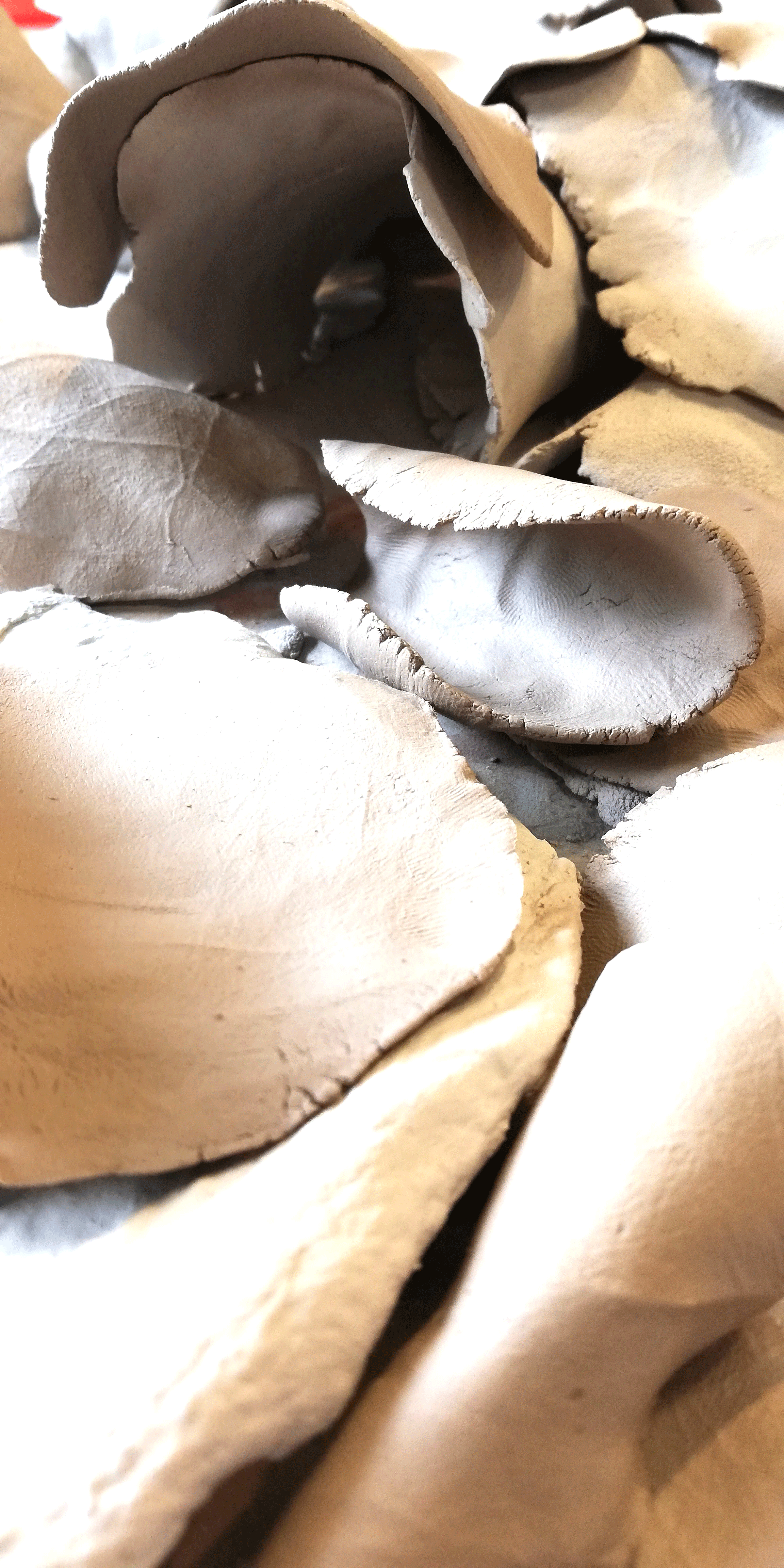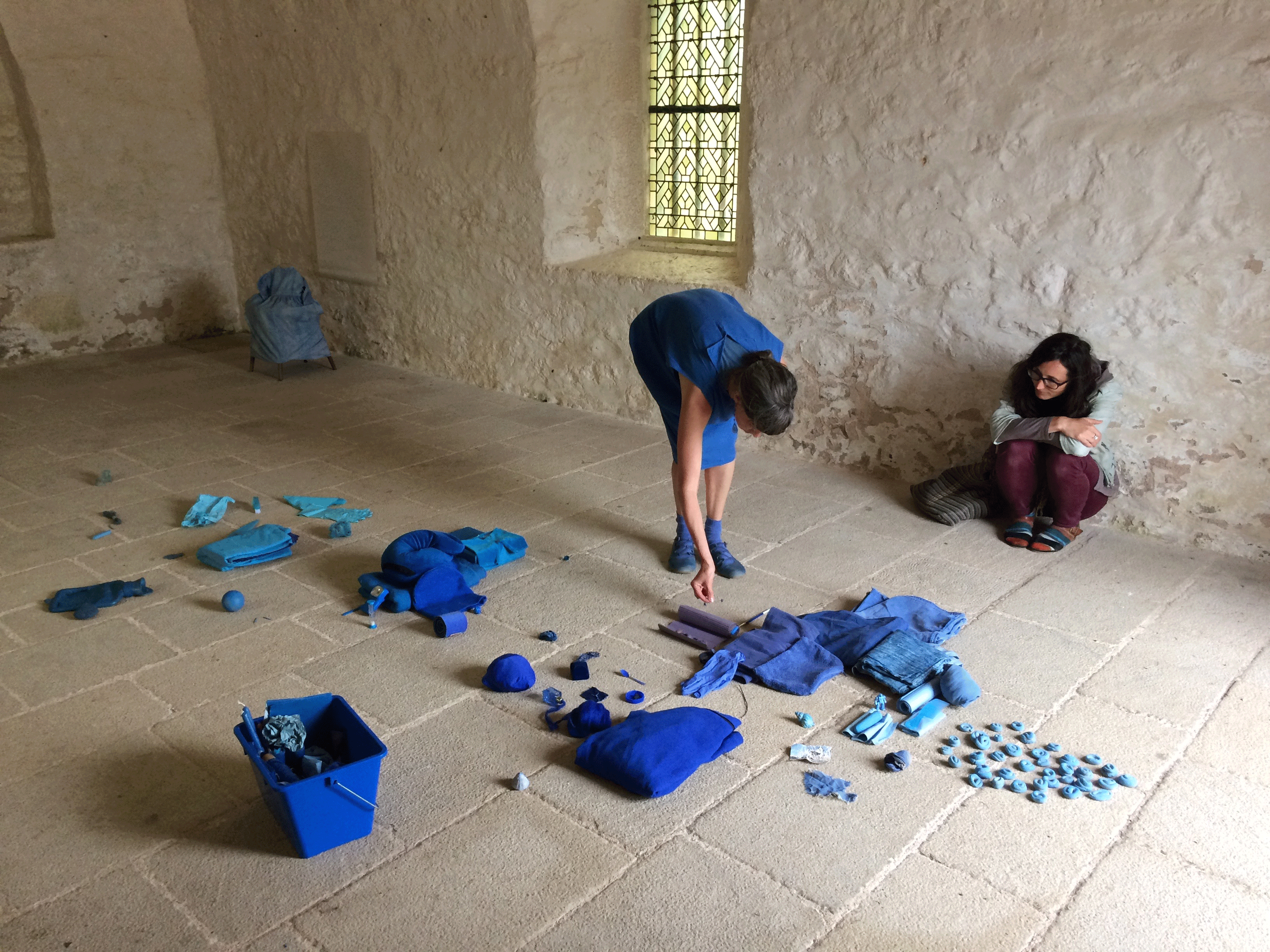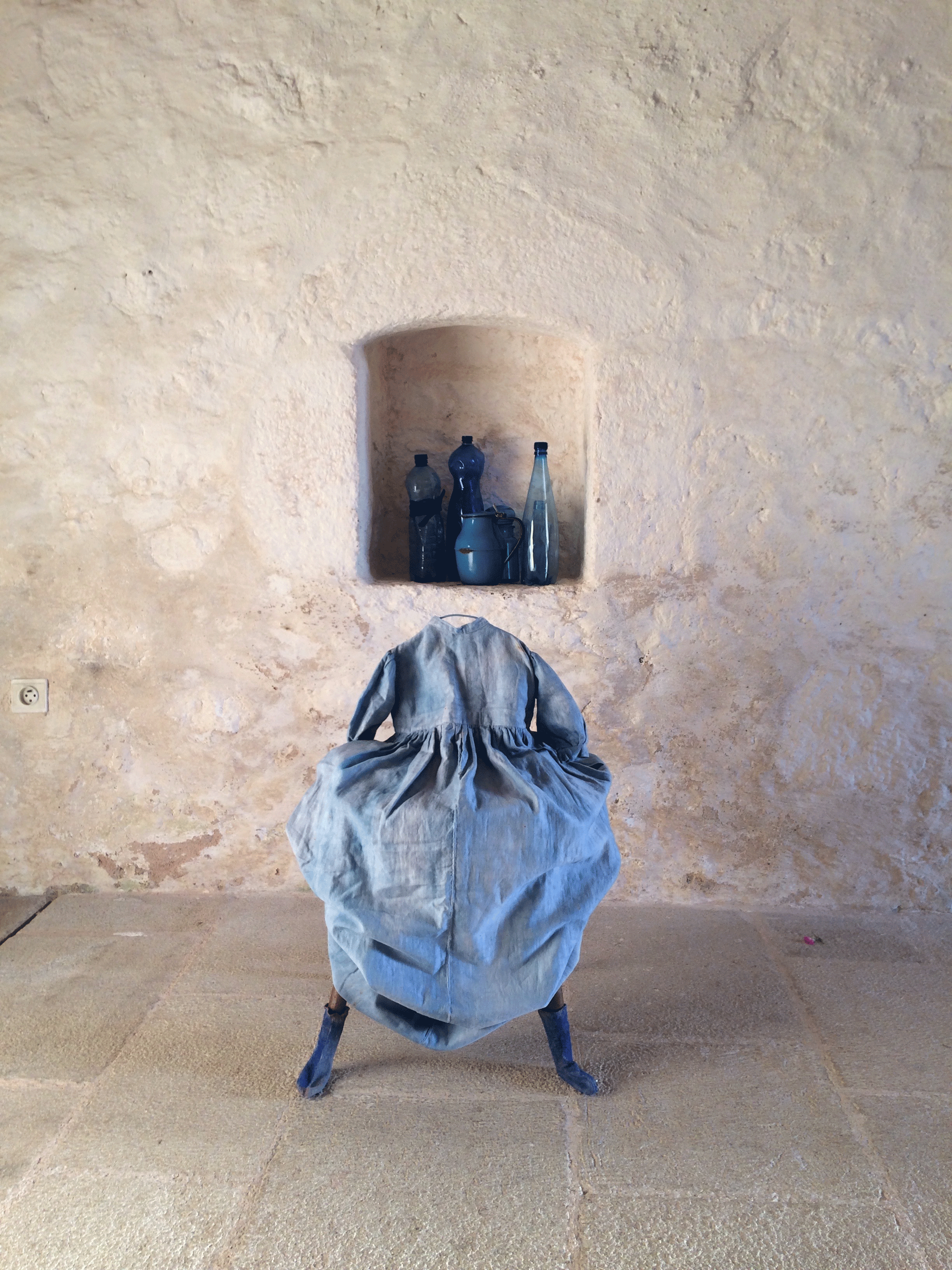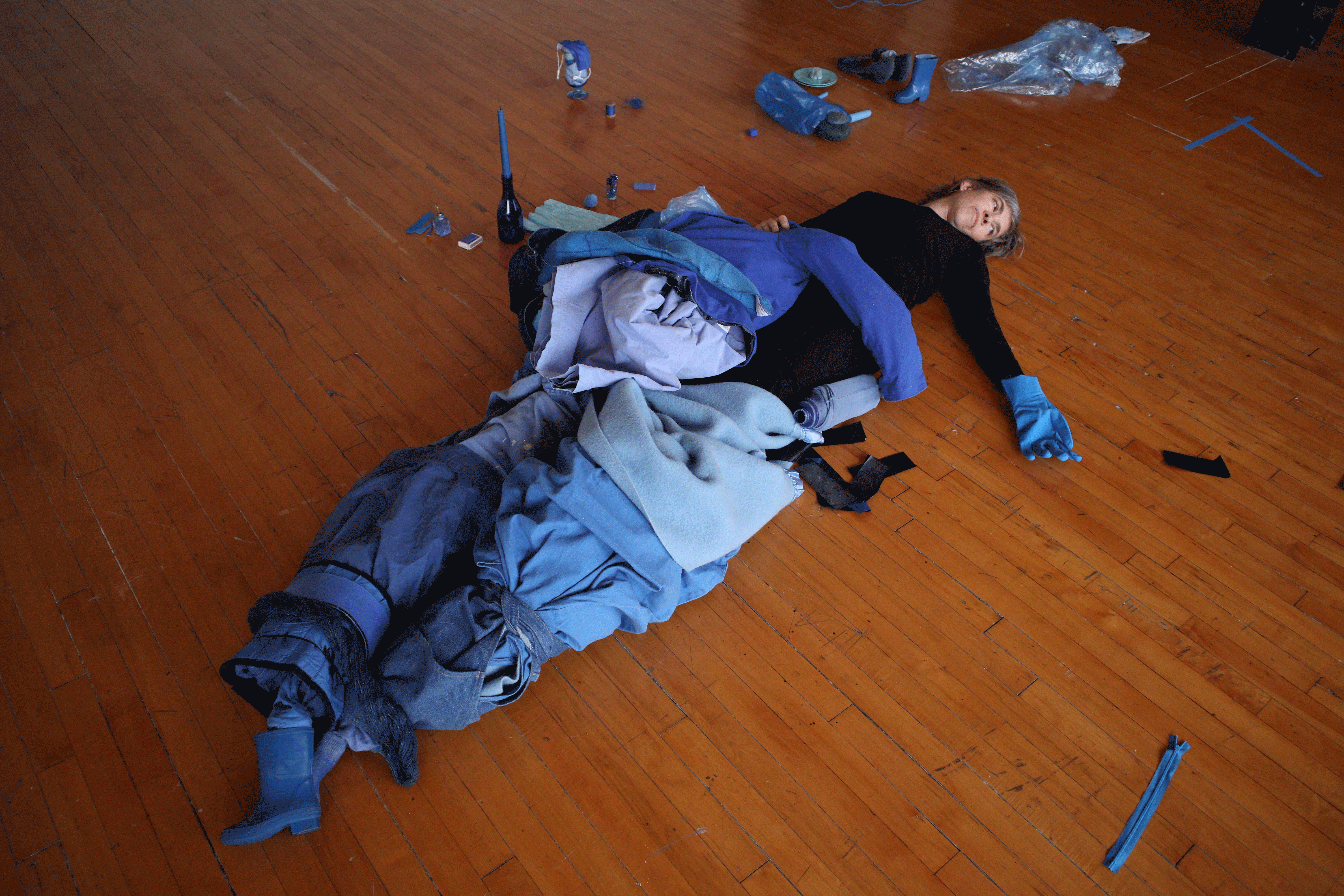Why is it that observing seems to be passive? While it may not be the most agitated act, it is nonetheless full of action. Observing means to listen, to watch, to feel, to touch. You need to be mindful, you need to focus and you need to evaluate. You have to fully process what you are observing while you are observing, otherwise it’s just looking at something.
But in the act of observing lies its own power. Once you begin to observe, stories begin to unfold. These stories, brought together by the cooperation of four women from various backgrounds all over the world, seem similar yet individually different at the same time.
The intangible efforts of observing, which these artists put into their work create very tactile objects. The materials seemingly invite touch and the artworks themselves evidently originated from manual labour and are a manifestation of artistic handcraft, where creation becomes narration.
By bringing together fragments of stories within their own narratives and by also allowing these to form a greater tale, Vida Simon, Mirjam Elburn, Maria Laura Galeotti and Laura Malvica show that there are many ways to tell many stories—and that we all might need to follow their lead and take a step back to calmly observe.
MIRJAM ELBURN
︎︎︎
Mirjam Elburn incorporates found and hand-crafted objects, material regarded as rubbish, as well as photography, to form site-specific work as well as work-in-progress. She uses old, time-consuming, manual craft techniques—e.g. felting or sewing—to create often ephemeral objects made of found material.
For a long time she has been working with human hair. She uses those techniques based on a repetitive action in a sculptural way and transposes them into a different context. The past is inherent in most of the material she uses: it is about the constant change, the unpredictable nature.
Her approach is improvisational and so she prefers encountering unknown, alternative spaces. Her work has been presented e.g. at Künstlerhaus Dortmund, Germany (2019); Espacio Little, Sevilla, Spain (2019); l’endroit indiqué, Montréal, Canada (2017); KUBA, Saarbrücken, Germany (2018); Galleria Oblom, Turin, Italy (2013)
︎
Mirjam Elburn verbindet gefundene und handgefertigtes Objekte, Material, das als Abfall. betrachtet wird, ebenso wie Fotografie um ortsspezifische Installationen ebenso wie prozessuale Arbeiten zu schaffen. Sie nutzt alte, zeitintensive Handarbeitstechniken — z.B. filze oder nähen — um oftmals ephemere Objekte aus Gefundenem zu schaffen.
Für eine lange Zeit hat sie mit menschlichem Haar gearbeitet. Sie nutzt die Techniken basierende auf einer wiederkehrenden Handlung skulptural und überführt sie in einen anderen Kontext. Die Vergangenheit wohnt dem meisten Material, das sie nutzt inne: es geht um den beständigen Wandel, die unberechenbare Natur der Dinge. Sie nährt sich improvisierend und bevorzugt so unbekannte, alternative Ausstellungsorte.
Ihre Arbeiten wurden unter anderem im Künstlerhaus Dortmund, Deutschland (2019); Espacio Little, Sevilla, Spanien (2019); l’endroit indiqué, Montréal, Kanada (2017); KUBA, Saarbrücken, Deutschland (2018); Galleria Oblom, Turin, Italien (2013) gezeigt.
︎
Mirjam Elburn incorpora objetos que se han hallado y obrado a mano, material que se considera basura, así como fotografía, para formar un trabajo específico para el lugar, así como un trabajo en progreso. Utiliza viejas técnicas de artesanía manual que requieren mucho tiempo, como por ejemplo el fieltro o la costura, para crear objetos a menudo efímeros hechos de material de desecho. Durante mucho tiempo ha estado trabajando con cabello humano. Utiliza las técnicas basadas en una acción repetitiva de forma escultórica y las traslada a un nuevo contexto diferente.
El pasado es inherente a la mayoría del material que utiliza: se trata del cambio constante, la naturaleza impredecible. Su enfoque es improvisado y así ella prefiere encontrarse con espacios desconocidos y alternativos.
Su trabajo ha sido presentado, por ejemplo, en Künstlerhaus Dortmund, Alemania (2019); Espacio Little, Sevilla, España (2019); l’endroit indiqué, Montreal, Canadá (2017); KUBA, Saarbrücken, Alemania (2018); Galleria Oblom, Turín, Italia (2013)




︎
VIDA SIMON
︎︎︎
Vida Simon combines various media to form site-responsive installations and performances. She has presented her work internationally in diverse contexts: galleries, hotel rooms, storefronts, theatres, rooftops, abandoned houses, a former synagogue, a horse stable, a tiny church …
Recent projects include Too much/Not enough at CIRCA, Montreal, Canada (2020); A Very Slow Blue, a performance on Ile Tatihou, France (2018); Ähnlichkeit, a solo exhibition at Kunsthalle Lingen, Germany (2017); Carried Away, an ongoing collaboration with Jack Stanley, Comox Valley Art Gallery, BC, Canada (2017), Galerie B-312, Montreal, Canada (2018), Villatalla, Italy (2018) and Villa des arts, Dakar, Senegal (2019).
Her work foregrounds improvisation, intimacy, fragility, and the resonance of ephemeral materials.
Recent projects include Too much/Not enough at CIRCA, Montreal, Canada (2020); A Very Slow Blue, a performance on Ile Tatihou, France (2018); Ähnlichkeit, a solo exhibition at Kunsthalle Lingen, Germany (2017); Carried Away, an ongoing collaboration with Jack Stanley, Comox Valley Art Gallery, BC, Canada (2017), Galerie B-312, Montreal, Canada (2018), Villatalla, Italy (2018) and Villa des arts, Dakar, Senegal (2019).
Her work foregrounds improvisation, intimacy, fragility, and the resonance of ephemeral materials.
︎
Vida Simon kombiniert verschiedenste Medien um ortsbezogene Installationen und Perfromances zu schaffen. Sie hat ihre Arbeit international in diversen Kontexten präsentiert: in Gallerien, Hotelzimmern, Schaufenstern, Theatern, auf Dächern, in verlassenen Häusern, einer ehemaligen Synagoge, einem Pferdestall, einer kleinen Kirche …
Zu ihren aktuellen Projekten gehören Too much/Not enough, CIRCA, Montreal, Kanada (2020), A Very Slow Blue, eine Performance auf der Ile Tatihou, Frankreich (2018); Ähnlichkeit, eine Einzelausstellung in der Kunsthalle Lingen, Deutschland (2017) und Carried Away, eine fortlaufende Kooperation mit Jack Stanley, Comox Valley Art Gallery, BC,Kanada (2017), Galerie B-312, Montreal, Kanada (2018), Villatalla, Italien (2018) und Villa des arts, Dakar, Senegal (2019).
Im Vordergrund ihrer Arbeit steht die Improvisation, Intimität, Zerbrechlichkeit und die Resonanz auf ephemeres Material.
︎
Vida Simon conecta varios medios para formar instalaciones y performancias de respuesta al lugar. Ha presentado su trabajo a nivel internacional en diversos contextos: galerías, habitaciones de hotel, tiendas, teatros, tejados, casas abandonadas, una antigua sinagoga, un establo de caballos, una pequeña iglesia …
Entre sus proyectos recientes se encuentran Too much/Not enough en CIRCA, Montreal, Canadá (2020); A Very Slow Blue, una actuación en Ile Tatihou, Francia (2018); Ähnlichkeit, una exposición individual en la Kunsthalle Lingen, Alemania (2017) y Carried Away, una colaboración actualmente llevada a cabo con Jack Stanley, Comox Valley Art Gallery, BC, Canadá (2017), Galerie B-312, Montreal, Canadá 2018, Villatalla, Italia (2018) y Villa des arts, Dakar, Senegal (2019).
Su obra destaca la improvisación, la intimidad, la fragilidad y la resonancia de los materiales efímeros.
She collects paper that is constantly being thrown away and she observes the birth of vegetation in the middle of concrete, thus creating a new landscape, portraying small habitats and showing themselves to be the survivors of the city’s progress.
The background (superimposed sheets of paper) is a result of human creation, essential in order to contrast with the subtlety of each plant preserved in the drawing.
The ceramic accompanies the action as an indicator that it is subjected to some sort of treatment, as well as the thin sheets that are created mechanically. Her artwork suggests thinking about “the end” of Being, the brittleness and the feeling of weight that the object can generate in space.
The following exhibitions—among those in which she participated—are particularly outstanding: May 2015 individual exhibition Instantes in the city of La Plata, Argentinia. She participated in the collective exhibitions of El Querido/Arte Contemporáneo (2016–2018): Una cosa es una cosa y otra cosa es otra cosa, Parafernalia, Mudar la Piel, Radicalmente Peores. She also made the individual exhibition Fragmento in Teatro Auditórium, Mar del Plata, Argentinia.
The background (superimposed sheets of paper) is a result of human creation, essential in order to contrast with the subtlety of each plant preserved in the drawing.
The ceramic accompanies the action as an indicator that it is subjected to some sort of treatment, as well as the thin sheets that are created mechanically. Her artwork suggests thinking about “the end” of Being, the brittleness and the feeling of weight that the object can generate in space.
The following exhibitions—among those in which she participated—are particularly outstanding: May 2015 individual exhibition Instantes in the city of La Plata, Argentinia. She participated in the collective exhibitions of El Querido/Arte Contemporáneo (2016–2018): Una cosa es una cosa y otra cosa es otra cosa, Parafernalia, Mudar la Piel, Radicalmente Peores. She also made the individual exhibition Fragmento in Teatro Auditórium, Mar del Plata, Argentinia.
︎
Laura Malvica sammelt Papier, das ständig weggeworfen wird und observiert die Geburt der Vegetation mitten aus Beton, so entsteht eine neue Landschaft, neue Lebensräume darstellend und als Überlebende des Fortschritts der Stadt zu zeigen.
Der Hintergrund (überlagerte Blätter Papier) ist ein Resultat der menschlichen Schöpfung, essentiell um mit der Subtilität jeder Pflanze konserviert in der Zeichnung zu kontrastieren.
Die Keramik begleitet die Handlung als Indikator dafür, dass sie einer Behandlung unterzogen wird, ebenso wie die dünnen Blätter, die mechanisch hergestellt werden.
Ihre künstlerische Arbeit schlägt vor, über „das Ende“ des Seins nachzudenken, die Zerbrechlichkeit und das Gefühl von Gewicht, das ein Objekt im Raum generieren kann.
Die folgenden Ausstellungen — an denen sie unter anderem teilnahm — sind besonders zu erwähnen: Instantes, Einzelausstellung. La Plata, Argentinien (2015) und die Gruppenaustellungen von El Querido/Arte Contemporáneo (2016–2018): Una cosa es una cosa y otra cosa es otra cosa, Parafernalia, Mudar la Piel, Radicalmente Peores und die Einzelausstellung
Fragmento im Teatro Auditórium, Mar del Plata, Argentinien.
Der Hintergrund (überlagerte Blätter Papier) ist ein Resultat der menschlichen Schöpfung, essentiell um mit der Subtilität jeder Pflanze konserviert in der Zeichnung zu kontrastieren.
Die Keramik begleitet die Handlung als Indikator dafür, dass sie einer Behandlung unterzogen wird, ebenso wie die dünnen Blätter, die mechanisch hergestellt werden.
Ihre künstlerische Arbeit schlägt vor, über „das Ende“ des Seins nachzudenken, die Zerbrechlichkeit und das Gefühl von Gewicht, das ein Objekt im Raum generieren kann.
Die folgenden Ausstellungen — an denen sie unter anderem teilnahm — sind besonders zu erwähnen: Instantes, Einzelausstellung. La Plata, Argentinien (2015) und die Gruppenaustellungen von El Querido/Arte Contemporáneo (2016–2018): Una cosa es una cosa y otra cosa es otra cosa, Parafernalia, Mudar la Piel, Radicalmente Peores und die Einzelausstellung
Fragmento im Teatro Auditórium, Mar del Plata, Argentinien.
︎
A través de la recolección de papeles que se desechan constantemente y la observación del nacimiento de vegetación en medio del cemento crea un paisaje nuevo, retratando pequeños hábitats y mostrándose como sobrevivientes al avance de la ciudad.
El fondo (papeles superpuestos) es creación humana, necesaria para contrastar con la delicadeza de cada planta conservada en el dibujo.
La cerámica acompaña la acción como indicadora de que algo está pasando con ella y las finas láminas que se crean de forma mecánica. Su obra propone pensar en «el fin» del Ser, la fragilidad y la sensación de peso que puede generar el objeto en el espacio.
Dentro de las exposiciones en las que participó, se destacan: mayo de 2015 Instantes exposición individual en la ciudad de La Plata. Ha participado de las muestras colectivas de El Querido/Arte Contemporáneo (2016–2018): Una cosa es una cosa y otra cosa es otra cosa, Parafernalia, Mudar la Piel, Radicalmente Peores. También ha realizado muestras individuales Fragmento en Teatro Auditórium, Mar del Plata.
El fondo (papeles superpuestos) es creación humana, necesaria para contrastar con la delicadeza de cada planta conservada en el dibujo.
La cerámica acompaña la acción como indicadora de que algo está pasando con ella y las finas láminas que se crean de forma mecánica. Su obra propone pensar en «el fin» del Ser, la fragilidad y la sensación de peso que puede generar el objeto en el espacio.
Dentro de las exposiciones en las que participó, se destacan: mayo de 2015 Instantes exposición individual en la ciudad de La Plata. Ha participado de las muestras colectivas de El Querido/Arte Contemporáneo (2016–2018): Una cosa es una cosa y otra cosa es otra cosa, Parafernalia, Mudar la Piel, Radicalmente Peores. También ha realizado muestras individuales Fragmento en Teatro Auditórium, Mar del Plata.




︎
MARIA LAURA GALEOTTI
︎︎︎
This is the motivation of Maria Laura Galeotti: to reconnect us humans to the pace of Nature. Her artwork is the result of the collection and the selection of objects from nature.
Collection, selection and clay coating.
After that, fire appears, as an alchemic element: it is an act of transformation. Laura Galeotti has been developing her teaching in schools and higher education institutions, in particular at the Rogelio Yrurtia School of Ceramics, where she has been teaching since 2011.
In 2015, she was awarded a Group Research Grant by Fondo Nacional de las Artes. In 2017 she started her collective artistic research activities in the artistic group GRAPA.
Her work was exhibited in the city of Buenos Aires (Argentina)—outstanding where those in the Cultural Centre of the Japanese Embassy and the Perlotti Museum. In 2018, she participated in the 59th Annual International Ceramics Exhibition organized by CAAC and was awarded the 1st prize in the “Other Disciplines in Dialogue with Ceramics” category. In August 2019, she travelled to Spain and participated in an Artistic Residence at Airgentum Hoja de Ruta, exhibiting in the city of Seville, as a conclusion to her research activities and as her artwork.
In 2020, she awarded a Grant for Training in Contemporary Art by Glamart Agencia de Arte.
︎
Technokratische Zeiten. All aasalte Handwerk scheint ebenso vergessen wie der Kontakt zu primären Materialien – und nun erschient Stille zusammen mit den vier Elementen um uns als menschliche Wesen mit der Essenz des Lebens wieder zu verbinden.
Dies ist die Motivation von Maria Laura Galeotti: uns als Menschen wieder mit dem Tempo der Natur zu verbinden. Ihre künstlerische Arbeit ist das Resultat des Sammelns und Auswählens von Objekten aus der Natur.
Sammeln, Auswählen und Tonbeschichtung
Danach erscheint das Feuer als alchemistisches Element: es ist ein Akt der Transfomation.
Laura Galeotti entwickelte ihre Lehre in Schulen und Hochschuleinrichtungen, insbesondere in der Rogelio Yrurtia School of Ceramics, wo sie seit 2011 unterrichtet.
2015 wurde sie mit dem Gruppenforschungsstipendium der Fondo Nacional de las Artes ausgezeichnet. 2017 begann sie mit der gemeinsamen Forschung mit der Kuenstler-Gruppe GRAPA.
Ihre Arbeiten wurden in Buenos Aires (Argentinien) unter anderem im Cultural Centre of the Japanese Embassy und im Perlotti Museum gezeigt. 2018 nahm sie an der 59th Annual International Ceramics Exhibition der CAAC teil, wo sie mit dem ersten Preis in der Kategorie „Andere Disziplinen im Dialog mit Keramik“ ausgezeichnet wurde.
Im August 2019 reiste sie nach Spanien: der Aufenthalt in der Künstler-Residenz Airgentum Hoja de Ruta mündete in einer Ausstellung in Sevilla als Abschluss für ihr Forschungsvorhaben. 2020 wurde sie mit dem Stipendium für die Ausbildung in zeitgenössischer Kunst der Glamart Agencia de Arte ausgezeichnet.
︎
En tiempos tecnificados donde todo oficio ancestral parece olvidado, al igual que el contacto con los materiales primarios, aparece el silencio y los cuatro elementos para reconectarnos como seres humanos a la esencia de la vida.
La motivación de su obra es reconectarnos con los tiempos de la naturaleza. De la cosecha de objetos de la naturaleza y su selección, resulta la obra.
Cosecha, selección y baño de arcilla.
Luego aparece el fuego como elemento alquímico: es un acto de transformación. Laura Galeotti desarrollado su tarea docente en escuelas e institutos terciarios En particular en la Escuela de Cerámica Rogelio Yrurtia donde ha dictado clases como docente desde el año 2011.
En el año 2015 fue ganadora de una Beca de Investigación Grupal otorgado por el Fondo Nacional de las Artes. El año 2017 inicia su trabajo de investigación artística grupal en el colectivo artístico GRAPA.
Su obra ha sido expuesta en la ciudad de Buenos Aires (Argentina) donde se destacan el Centro Cultural de la Embajada de Japón y el Museo Perlotti.
En el año 2018 participó del 59° Salón Anual Internacional de Cerámica organizado por el CAAC y ganó el 1er premio en la categoría «Otras Disciplinas en Diálogo con la Cerámica». En agosto del año 2019 viaja a España y realiza una Residencia Artística en Airgentum Hoja de Ruta, exponiendo como cierre de su trabajo de investigación y obra en la ciudad de Sevilla.
En el 2020 es ganadora de una Beca de Formación en Arte Contemporáneo de Glamart Agencia de Arte.





